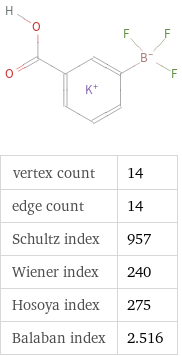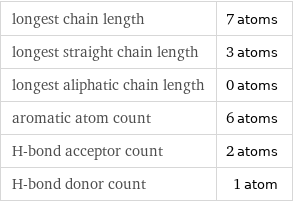Input interpretation

potassium 3-carboxyphenyltrifluoroborate
Basic properties
(F)F)C(=O)O.[K+] InChI identifier | InChI=1/C7H5BF3O2.K/c9-8(10, 11)6-3-1-2-5(4-6)7(12)13;/h1-4H, (H, 12, 13);/q-1;+1/f/h12H; InChI key | LKEMWADDENRLDB-UHFFFAOYSA-N](../image_source/215e7fa1289ff59108c82007d8ad9fa7.png)
molar mass | 228 g/mol formula | C_7H_5BF_3KO_2 empirical formula | C_7O_2B_F_3K_H_5 SMILES identifier | C1=CC(=CC(=C1)[B-](F)(F)F)C(=O)O.[K+] InChI identifier | InChI=1/C7H5BF3O2.K/c9-8(10, 11)6-3-1-2-5(4-6)7(12)13;/h1-4H, (H, 12, 13);/q-1;+1/f/h12H; InChI key | LKEMWADDENRLDB-UHFFFAOYSA-N
Structure diagram

vertex count | 14 edge count | 14 Schultz index | 957 Wiener index | 240 Hosoya index | 275 Balaban index | 2.516
Quantitative molecular descriptors

longest chain length | 7 atoms longest straight chain length | 3 atoms longest aliphatic chain length | 0 atoms aromatic atom count | 6 atoms H-bond acceptor count | 2 atoms H-bond donor count | 1 atom
Elemental composition

Find the elemental composition for potassium 3-carboxyphenyltrifluoroborate in terms of the atom and mass percents: atom percent = N_i/N_atoms × 100% mass percent = (N_im_i)/m × 100% Plan: • Write the chemical formula and gather atomic masses from the periodic table. • Determine values for N_i, m_i, N_atoms and m using these items. • Finally, compute the percents and check the results. Write the chemical formula: C_7H_5BF_3KO_2 Use the chemical formula to count the number of atoms, N_i, for each element and find the total number of atoms, N_atoms, per molecule: | number of atoms C (carbon) | 7 O (oxygen) | 2 B (boron) | 1 F (fluorine) | 3 K (potassium) | 1 H (hydrogen) | 5 N_atoms = 7 + 2 + 1 + 3 + 1 + 5 = 19 Divide each N_i by N_atoms to calculate atom fractions. Then use the property that atom fractions must sum to one to check the work: | number of atoms | atom fraction C (carbon) | 7 | 7/19 O (oxygen) | 2 | 2/19 B (boron) | 1 | 1/19 F (fluorine) | 3 | 3/19 K (potassium) | 1 | 1/19 H (hydrogen) | 5 | 5/19 Check: 7/19 + 2/19 + 1/19 + 3/19 + 1/19 + 5/19 = 1 Compute atom percents using the atom fractions: | number of atoms | atom percent C (carbon) | 7 | 7/19 × 100% = 36.8% O (oxygen) | 2 | 2/19 × 100% = 10.5% B (boron) | 1 | 1/19 × 100% = 5.26% F (fluorine) | 3 | 3/19 × 100% = 15.8% K (potassium) | 1 | 1/19 × 100% = 5.26% H (hydrogen) | 5 | 5/19 × 100% = 26.3% Look up the atomic mass, m_i, in unified atomic mass units, u, for each element in the periodic table: | number of atoms | atom percent | atomic mass/u C (carbon) | 7 | 36.8% | 12.011 O (oxygen) | 2 | 10.5% | 15.999 B (boron) | 1 | 5.26% | 10.81 F (fluorine) | 3 | 15.8% | 18.998403163 K (potassium) | 1 | 5.26% | 39.0983 H (hydrogen) | 5 | 26.3% | 1.008 Multiply N_i by m_i to compute the mass for each element. Then sum those values to compute the molecular mass, m: | number of atoms | atom percent | atomic mass/u | mass/u C (carbon) | 7 | 36.8% | 12.011 | 7 × 12.011 = 84.077 O (oxygen) | 2 | 10.5% | 15.999 | 2 × 15.999 = 31.998 B (boron) | 1 | 5.26% | 10.81 | 1 × 10.81 = 10.81 F (fluorine) | 3 | 15.8% | 18.998403163 | 3 × 18.998403163 = 56.995209489 K (potassium) | 1 | 5.26% | 39.0983 | 1 × 39.0983 = 39.0983 H (hydrogen) | 5 | 26.3% | 1.008 | 5 × 1.008 = 5.040 m = 84.077 u + 31.998 u + 10.81 u + 56.995209489 u + 39.0983 u + 5.040 u = 228.018509489 u Divide the mass for each element by m to calculate mass fractions. Then use the property that mass fractions must sum to one to check the work: | number of atoms | atom percent | mass fraction C (carbon) | 7 | 36.8% | 84.077/228.018509489 O (oxygen) | 2 | 10.5% | 31.998/228.018509489 B (boron) | 1 | 5.26% | 10.81/228.018509489 F (fluorine) | 3 | 15.8% | 56.995209489/228.018509489 K (potassium) | 1 | 5.26% | 39.0983/228.018509489 H (hydrogen) | 5 | 26.3% | 5.040/228.018509489 Check: 84.077/228.018509489 + 31.998/228.018509489 + 10.81/228.018509489 + 56.995209489/228.018509489 + 39.0983/228.018509489 + 5.040/228.018509489 = 1 Compute mass percents using the mass fractions: Answer: | | | number of atoms | atom percent | mass percent C (carbon) | 7 | 36.8% | 84.077/228.018509489 × 100% = 36.87% O (oxygen) | 2 | 10.5% | 31.998/228.018509489 × 100% = 14.03% B (boron) | 1 | 5.26% | 10.81/228.018509489 × 100% = 4.741% F (fluorine) | 3 | 15.8% | 56.995209489/228.018509489 × 100% = 25.00% K (potassium) | 1 | 5.26% | 39.0983/228.018509489 × 100% = 17.15% H (hydrogen) | 5 | 26.3% | 5.040/228.018509489 × 100% = 2.210%
Elemental oxidation states

The first step in finding the oxidation states (or oxidation numbers) in potassium 3-carboxyphenyltrifluoroborate is to draw the structure diagram. Next set every oxidation number equal to the atom's formal charge: In potassium 3-carboxyphenyltrifluoroborate hydrogen is not bonded to a metal with lower electronegativity, so it will have an oxidation state of +1. Any element bonded to hydrogen gains the bonding electrons, decreasing their oxidation state by 1 for every bond: With hydrogen out of the way, look at the remaining bonds. There are 1 boron-carbon bond, 3 boron-fluorine bonds, 2 carbon-oxygen bonds, and 7 carbon-carbon bonds. For each of these bonds, assign the bonding electrons to the most electronegative element. First examine the boron-carbon bond: element | electronegativity (Pauling scale) | B | 2.04 | C | 2.55 | | | Since carbon is more electronegative than boron, the electrons in this bond will go to carbon. Decrease the oxidation number for carbon (by 1 for single bonds, 2 for double bonds, and 3 for triple bonds), and increase the oxidation number for boron accordingly: Next look at the boron-fluorine bonds: element | electronegativity (Pauling scale) | B | 2.04 | F | 3.98 | | | Since fluorine is more electronegative than boron, the electrons in these bonds will go to fluorine: Next look at the carbon-oxygen bonds: element | electronegativity (Pauling scale) | C | 2.55 | O | 3.44 | | | Since oxygen is more electronegative than carbon, the electrons in these bonds will go to oxygen: Next look at the carbon-carbon bonds: element | electronegativity (Pauling scale) | C | 2.55 | C | 2.55 | | | Since these elements are the same the bonding electrons are shared equally, and there is no change to the oxidation states: Now summarize the results: Answer: | | oxidation state | element | count -2 | O (oxygen) | 2 -1 | C (carbon) | 5 | F (fluorine) | 3 0 | C (carbon) | 1 +1 | H (hydrogen) | 5 | K (potassium) | 1 +3 | B (boron) | 1 | C (carbon) | 1
Orbital hybridization

hybridization | element | count sp^2 | C (carbon) | 7 | O (oxygen) | 2 sp^3 | B (boron) | 1 | F (fluorine) | 3
Structure diagram

Orbital hybridization Structure diagram
Topological indices

vertex count | 19 edge count | 18 Schultz index | 2038 Wiener index | 531 Hosoya index | 2286 Balaban index | 3.079